
Dewick P.M. Medicinal natural products VCH-Wiley, Weinheim, 2002 / booktext@id88013692placeboie
.pdf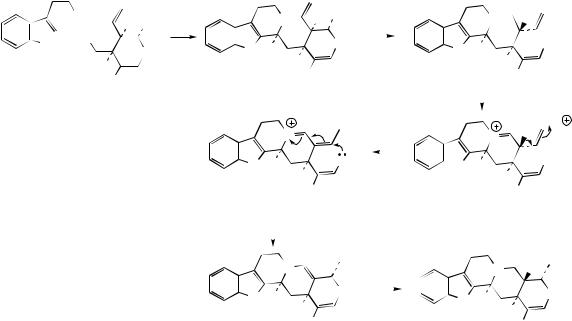
ALKALOIDS DERIVED FROM TRYPTOPHAN |
351 |
NH2
 OHC N
OHC N
H tryptamine
|
|
|
|
|
|
|
hydrolysis of glycoside liberates hemiacetal; |
|
||||||||||||
|
|
Mannich-like |
|
|
|
|
further hydrolysis produces aldehyde and |
|
|
|||||||||||
|
|
|
|
|
|
alcohol; note rotation about C–C bond |
|
|
||||||||||||
|
|
reaction |
|
|
|
|
|
|
||||||||||||
|
|
|
|
|
NH H OGlc |
|
|
|
|
|
|
|
|
|
|
|
CHO |
|
||
|
|
|
|
|
|
|
|
|
|
|
|
|
|
|
|
|
|
|||
|
H OGlc |
|
|
|
|
|
– Glc |
|
NH |
H |
|
|||||||||
|
|
O |
|
N |
H |
O |
|
|
|
|
|
|
|
|
N |
H |
OH |
|||
|
|
|
|
|
|
|
|
|
|
|
||||||||||
|
|
|
|
|
|
|
|
|
|
|
||||||||||
|
|
|
|
|
|
|
|
|
|
|
|
|
|
|||||||
|
|
|
|
H |
|
H |
|
|
|
|
|
|
|
|
|
H |
|
H |
|
|
H |
CO2Me |
|
||||||||||||||||||
|
|
|
|
|
|
|
|
|
|
|
|
|
|
|
CO2Me |
|
||||
CO2Me |
|
strictosidine |
|
|
|
|
|
|
|
|
|
|
|
|
||||||
|
|
|
|
|
|
|
|
|
|
|
|
Schiff base |
|
|||||||
secologanin |
|
|
|
|
|
allylic isomerization |
|
|
||||||||||||
|
|
|
|
|
|
formation |
|
|||||||||||||
|
|
|
|
|
|
|
|
|
|
|||||||||||
|
|
|
|
|
|
|
|
favouring conjugation |
|
|
|
|
||||||||
|
|
|
|
|
|
N |
|
|
|
|
|
|
|
|
|
|
|
N |
H |
H |
|
|
|
|
|
|
|
|
|
|
|
|
|
|
|
|
|
|
|||
|
|
|
|
|
|
|
|
|
|
|
|
|
|
|
|
|
|
|
||
attack of nucleophile on |
|
N |
H |
OH |
|
|
|
|
|
|
|
|
N |
H |
OH |
|||||
|
|
|
|
|
|
|
|
|
||||||||||||
|
|
|
|
|
|
|
|
|
||||||||||||
|
|
|
|
|
|
|
|
|
||||||||||||
|
|
|
|
|
|
|
|
|
|
|
|
|||||||||
to α,β-unsaturated |
|
H |
|
H |
|
|
|
|
|
|
|
|
|
H |
|
H |
|
|||
|
|
|
|
CO2Me |
|
|
|
|
|
|
|
|
|
|
|
CO2Me |
|
|||
iminium ion |
|
|
|
|
|
|
|
|
|
|
|
|
|
|
|
|
||||
|
|
|
dehydrogeissoschizine |
|
|
|
|
|
|
|
|
|
|
|
|
|
||||
|
|
|
|
(enol form) |
|
|
|
|
|
|
|
|
|
|
|
|
|
|
||
|
|
|
|
|
|
N |
|
|
NADPH |
|
|
N |
H |
|
||||||
|
|
|
|
|
|
|
|
|
|
|
||||||||||
|
|
|
|
|
|
|
|
|
|
|
||||||||||
|
|
|
|
N |
H |
O |
|
N |
H |
|
O |
|||||||||
|
|
|
|
|
|
|
|
|
|
|
|
|
||||||||
|
|
|
|
|
|
|
|
|
|
|
|
|
||||||||
|
|
|
|
|
|
|
|
|
|
|
|
|
|
|
||||||
|
|
|
|
H |
|
H |
|
|
|
|
|
|
|
|
|
H |
|
|
H |
|
|
|
|
|
cathenamine |
CO2Me |
|
|
|
|
|
|
|
|
ajmalicine |
CO2Me |
|||||
|
|
|
|
|
|
|
|
|
|
|
|
|
|
|
||||||
Figure 6.76
be related and rationalized in terms of rearrangements occurring in the terpenoid part of the structures (Figure 6.75). Secologanin itself contains the ten-carbon framework typical of the Corynanthe group. The Aspidosperma and Iboga groups could then arise by rearrangement of the Corynanthe skeleton as shown. This is represented by detachment of a three-carbon unit, which is then rejoined to the remaining C7 fragment in one of two different ways. Where C9 terpenoid units are observed, the alkaloids normally appear to have lost the carbon atom indicated in the circle. This corresponds to the carboxylate function of secologanin and its loss by hydrolysis/decarboxylation is now understandable.
The origins of loganin and secologanin have already been discussed in Chapter 5 (see page 189). Condensation of secologanin with tryptamine in a Mannich-like reaction generates the tetrahydro- β-carboline system and produces strictosidine (Figure 6.76). Hydrolysis of the glycoside function allows opening of the hemiacetal, and exposure of an aldehyde group, which can react with
the secondary amine function giving a quaternary Schiff base. These reactions are also seen in the pathway to ipecac alkaloids (see page 343). Allylic isomerization, moving the vinyl double bond into conjugation with the iminium generates dehydrogeissoschizine, and cyclization to cathenamine follows. Cathenamine is reduced to ajmalicine in the presence of NADPH.
Carbocyclic variants related to ajmalicine such as yohimbine are likely to arise from dehydrogeissoschizine by the mechanism indicated in Figure 6.77. Yohimbine is found in Yohimbe bark (Pausinystalia yohimbe; Rubiaceae) and Aspidosperma bark (Aspidosperma species; Apocynaceae) and has been used in folk medicine as an aphrodisiac. It does have some pharmacological activity and is known to dilate blood vessels. More important examples containing the same carbocyclic ring system are the alkaloids found in species of Rauwolfia , especially R. serpentina (Apocynaceae). Reserpine and deserpidine (Figure 6.78) are trimethoxybenzoyl esters of yohimbine-like alkaloids, whilst rescinnamine is
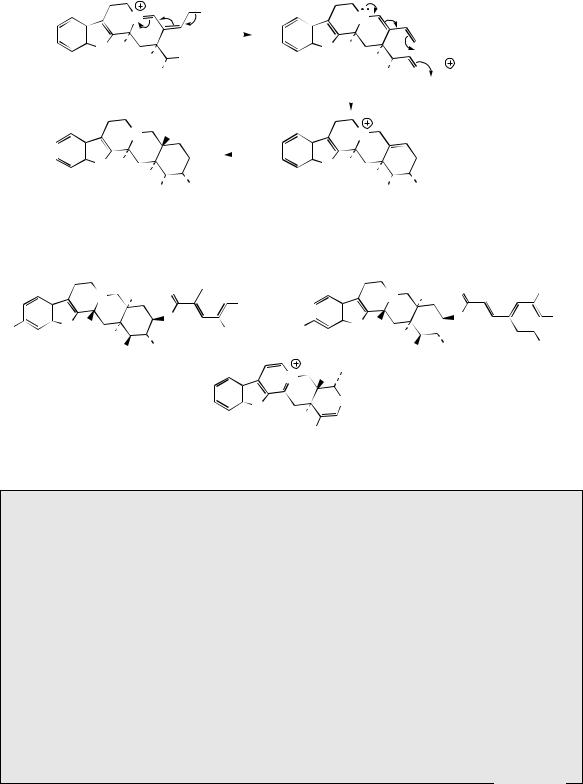
352 |
|
|
|
|
|
|
|
|
|
|
|
|
|
|
ALKALOIDS |
|
|
|
|
|
|
|
|
|
|
|
|
|
homoallylic isomerization |
|
|
|
|
nucleophilic attack on to |
|
||||||||||||
|
|
|
|
N |
|
H |
|
|
|
|
|
|
|
|
|
|
N |
|
carbonyl through |
|
|||
|
|
|
|
|
|
|
|
|
|
|
|
|
|
|
|
conjugated system |
|
||||||
|
|
|
|
|
|
|
|
|
|
|
|
|
|
|
|
|
|
|
|||||
|
|
|
N |
H |
|
CHO |
|
|
|
|
|
|
|
|
N |
H |
|
|
|
|
|
||
|
|
|
|
|
|
|
|
|
|
|
|
|
|
|
|
|
|||||||
|
|
|
|
|
|
|
|
|
|
|
|
|
|
|
|
|
|||||||
|
|
|
|
|
|
|
|
|
|
|
|
|
|
|
|
|
|||||||
|
|
|
H |
H |
|
|
|
|
|
|
|
|
|
H |
|
H |
O H |
|
|
|
|||
|
|
|
|
|
CO2Me |
|
|
|
|
|
|
|
|
|
|
MeO2C |
|
|
|
||||
|
|
dehydrogeissoschizine |
|
|
|
|
|
|
|
|
|
|
|
|
|
|
|
|
|
|
|||
|
|
|
|
|
|
|
|
|
|
|
|
|
|
|
|
|
|
|
|||||
|
|
|
(keto form) |
|
|
|
|
|
|
|
|
|
|
|
|
|
|
|
|
|
|
|
|
|
|
|
|
N |
H |
|
|
reduction |
|
|
|
N |
|
|
|
|
|
||||||
|
|
|
N |
H |
|
|
|
|
|
|
|
|
|
|
|
N |
H |
|
|
|
|
|
|
|
|
|
|
|
|
|
|
|
|
|
|
|
|
|
|
|
|
|
|||||
|
|
|
|
|
|
|
|
|
|
|
|
|
|
|
|
|
|
|
|||||
|
|
|
H |
H |
|
OH |
|
|
|
|
|
|
|
|
H |
|
H |
OH |
|
|
|
||
|
|
|
|
MeO2C |
|
|
|
|
|
|
|
|
|
|
MeO2C |
|
|
|
|||||
|
|
|
|
|
|
|
|
|
|
|
|
|
|
|
|
|
|
|
|
|
|||
|
|
|
yohimbine |
|
|
|
|
|
|
|
|
|
|
|
|
|
|
|
|
|
|
|
|
|
|
|
|
|
|
|
|
|
|
|
|
|
|
Figure 6.77 |
|
|
|
|
|
|
|
||
|
|
|
|
|
|
|
|
|
OMe |
|
|
|
|
|
|
|
|
|
|||||
|
|
|
N |
H |
O |
|
|
|
|
|
OMe |
|
|
|
N |
|
H |
O |
OMe |
||||
|
|
|
|
|
|
|
|
|
|
|
|
||||||||||||
|
|
|
|
|
|
|
|
|
|
|
|
|
|
|
|
||||||||
11 |
|
3 |
|
O |
|
|
|
|
|
|
|
|
N H |
|
|
O |
OMe |
||||||
|
|
|
|
|
|
|
|
|
|
|
|
||||||||||||
|
N H |
|
|
|
|
|
|
|
|
|
|
MeO |
|
|
|
|
|||||||
|
|
|
|
|
|
|
|
|
|
|
|
|
|
|
|||||||||
R |
|
|
|
|
|
|
OMe |
|
|
H |
|
|
|
|
|||||||||
|
H |
H |
OMe |
|
|
|
|
|
H |
OMe |
OMe |
||||||||||||
|
|
|
|
|
|
|
|
|
|
|
|
|
|
||||||||||
|
|
|
MeO2C |
|
|
|
|
|
|
|
|
|
|
|
|
MeO2C |
|||||||
|
|
|
|
|
|
|
|
|
|
|
|
|
|
|
|
|
|
|
|
||||
|
|
|
R = OMe, reserpine |
|
|
|
|
|
|
|
|
|
N |
H |
|
|
rescinnamine |
|
|
|
|||
|
|
|
R = H, deserpidine |
|
|
|
|
|
|
|
|
|
|
|
|
|
|
|
|
||||
|
|
|
|
|
|
|
|
|
|
|
|
|
|
|
|
|
|
|
|
||||
|
|
|
|
|
|
|
|
|
|
|
|
|
|
N |
H |
|
O |
|
|
|
|
|
|
|
|
|
|
|
|
|
|
|
|
|
|
|
|
|
|
|
|
|
|
||||
|
|
|
|
|
|
|
|
|
|
|
|
|
|
|
|
|
|
|
|
|
|
||
|
|
|
|
|
|
|
|
|
|
|
|
|
|
H |
|
|
|
|
|
|
|
|
|
CO2Me
serpentine
Figure 6.78
Rauwolfia
Rauwolfia has been used in Africa for hundreds of years, and in India for at least 3000 years. It was used as an antidote to snake-bite, to remove white spots in the eyes, against stomach pains, fever, vomiting, and headache, and to treat insanity. It appeared to be a universal panacea, and was not considered seriously by Western scientists until the late 1940s/early 1950s. Clinical tests showed the drug to have excellent antihypertensive and sedative activity. It was then rapidly and extensively employed in treating high blood pressure and to help mental conditions, relieving anxiety and restlessness, and thus initiating the tranquillizer era. The ‘cure for insanity’ was thus partially justified, and rauwolfia was instrumental in showing that mental disturbance has a chemical basis and may be helped by the administration of drugs.
Rauwolfia is the dried rhizome and roots of Rauwolfia (sometimes Rauvolfia) serpentina (Apocynaceae) or snakeroot, a small shrub from India, Pakistan, Burma, and Thailand. Other species used in commerce include R. vomitoria from tropical Africa, a small tree whose leaves after ingestion cause violent vomiting, and R. canescens (= R. tetraphylla) from India and the
(Continues)

ALKALOIDS DERIVED FROM TRYPTOPHAN |
353 |
(Continued )
Caribbean. Most of the drug material has been collected from the wild. Rauwolfia serpentina contains a wide range of indole alkaloids, totalling 0.7–2.4%, though only 0.15–0.2% consists of desirable therapeutically active compounds, principally reserpine, rescinnamine, and deserpidine (Figure 6.78). Other alkaloids of note are serpentine (Figure 6.78), ajmalicine (Figure 6.76), and ajmaline (see Figure 6.82). Reserpine and deserpidine are major alkaloids in R. canescens, and R. vomitoria contains large amounts of rescinnamine and reserpine.
Reserpine and deserpidine (Figure 6.78) have been widely used as antihypertensives and mild tranquillizers. They act by interfering with catecholamine storage, depleting levels of available neurotransmitters. Prolonged use of the pure alkaloids, reserpine in particular, has been shown to lead to severe depression in some patients, a feature not so prevalent when the powdered root was employed. The complex nature of the alkaloidal mixture means the medicinal action is somewhat different from that of reserpine alone. Accordingly, crude powdered rauwolfia remained an important drug for many years, and selected alkaloid fractions from the crude extract have also been widely used. The alkaloids can be fractionated according to basicity. Thus, serpentine and similar structures are strongly basic, whilst reserpine, rescinnamine, deserpidine and ajmalicine are weak bases. Ajmaline and related compounds have intermediate basicity.
The rauwolfia alkaloids are now hardly ever prescribed in the UK, either as antihypertensives or as tranquillizers. Over a period of a few years, they have been rapidly superseded by synthetic alternatives. Reserpine has also been suggested to play a role in the promotion of breast cancers. Both ajmalicine (= raubasine) (Figure 6.76) and ajmaline (Figure 6.82) are used clinically in Europe, though not in the UK. Ajmalicine is employed as an antihypertensive, whilst ajmaline is of value in the treatment of cardiac arrhythmias. Ajmalicine is also extracted commercially from Catharanthus roseus (see page 357).
a trimethoxycinnamoyl ester. Both reserpine and rescinnamine contain an additional methoxyl substituent on the indole system at position 11, the result of hydroxylation and methylation at a late stage in the pathway. A feature of these alkaloids is that they have the opposite stereochemistry at position 3 to yohimbine and strictosidine. Rauwolfia serpentina also contains significant amounts of ajmalicine (Figure 6.76), emphasizing the structural and biosynthetic relationships between the two types of alkaloid.
The structural changes involved in converting the Corynanthe type skeleton into those of the Aspidosperma and Iboga groups are quite complex, and are summarized in Figure 6.79. Early intermediates are alkaloids such as preakuammicine, which, although clearly of the Corynanthe type, is sometimes designated as Strychnos type (compare strychnine, page 358). This is because the Corynanthe terpenoid unit, originally attached to the indole α-carbon, is now bonded to the β-carbon, and a new bonding between the rearrangeable C3 unit and C-α is in place. Stemmadenine arises through fission
of the bond to C-β, and then further fission yields a hypothetical intermediate, the importance of which is that the rearrangeable C3 unit has been cleaved from the rest of the terpenoid carbons. Alkaloids of the Aspidosperma type, e.g. tabersonine and vindoline, and Iboga type, e.g. catharanthine, then arise from this intermediate by different bonding modes (Figure 6.79).
Many of the experimental studies that have led to an understanding of terpenoid indole alkaloid biosynthesis have been carried out using plants of the Madagascar periwinkle (Catharanthus roseus , formerly Vinca rosea; Apocynaceae). Representatives of all the main classes of these alkaloids are produced, including ajmalicine (Corynanthe), catharanthine (Iboga), and vindoline (Aspidosperma). The sequence of alkaloid formation has been established initially by noting which alkaloids become labelled as a feeding experiment progresses, and more recently by appropriate enzymic studies. However, the extensive investigations of the Catharanthus roseus alkaloids have also been prompted by the anticancer activity
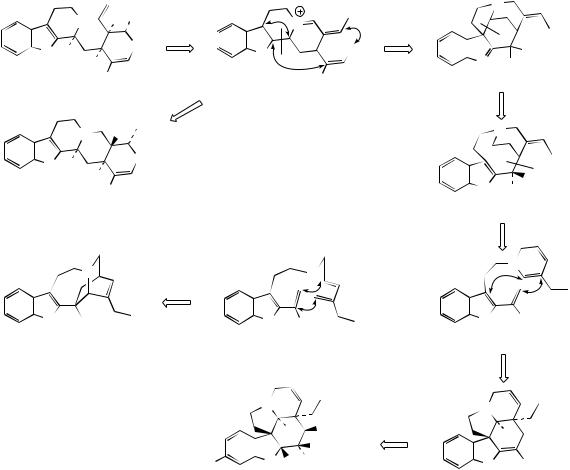
354 |
|
|
|
|
|
ALKALOIDS |
|
|
|
|
||
|
|
|
|
|
|
|
|
|
|
|
|
N |
|
|
NH |
H OGlc |
|
|
|
b |
N |
a |
|
|
|
|
|
|
|
|
|
|
|
|
|
|||
|
|
|
|
|
|
|
|
|
|
|
|
|
|
|
|
O |
|
|
|
|
|
b |
|
|
|
|
N |
H |
|
|
N |
|
|
OH |
|
N |
CH2OH |
|
|
|
|
|
|
|
|||||||
|
|
|
|
|
|
|
||||||
|
|
|
|
|||||||||
|
H |
H |
|
|
|
H |
b |
|
|
|
CO2Me |
|
|
|
|
CO2Me |
|
|
|
CO2Me |
preakuammicine |
||||
|
strictosidine |
|
|
|
|
|||||||
|
a |
dehydrogeissoschizine |
|
|
|
|
||||||
|
|
|
|
|
|
|
||||||
|
|
|
|
|
(enol form) |
|
|
|
|
|||
|
|
|
|
|
|
|
|
|
|
|||
|
|
N |
H |
|
|
|
|
|
|
|
|
N |
|
N |
H |
O |
|
|
|
|
|
|
|
|
|
|
|
|
|
|
|
|
|
|
|
|||
|
|
|
|
|
|
|
|
|
|
|||
|
|
|
|
|
|
|
|
|
|
|
||
|
H |
H |
|
|
|
|
|
|
|
|
N |
CH2OH |
|
|
|
|
|
|
|
|
|||||
|
ajmalicine |
CO2Me |
|
|
|
|
|
|
|
CO2Me |
||
|
|
|
|
|
|
|
|
|
H |
|
||
|
|
|
|
|
|
|
|
|
|
|
stemmadenine |
|
|
|
|
|
|
|
|
|
|
this represents formal cleavage |
|
||
|
|
|
|
|
|
|
|
|
of the C3 unit during the |
|
|
|
|
|
|
Diels–Alder type |
|
|
|
|
|
rearrangement process |
|
|
|
|
|
|
|
|
|
|
|
|
|
|
N |
|
|
|
N |
reaction |
|
|
|
|
N |
|
|
|
|
|
|
|
|
|
|
|
|
|
|
|||
|
N |
CO2Me |
|
|
N |
|
CO2Me |
≡ |
|
N |
CO2Me |
|
|
|
|
|
|
||||||||
|
|
|
|
|
|
|||||||
|
H |
|
|
|
|
H |
|
|
|
|
H |
|
|
catharanthine |
|
|
|
|
|
|
hypothetical intermediate |
||||
|
N |
|
N |
|
|
|
|
|
|
|
H |
OAc |
H |
|
|
|
|
|
|
|
|
OH |
|
|
MeO |
N H |
CO2Me |
N |
CO2Me |
|
Me |
|
H |
|
|
|
|
|
|
|
vindoline |
|
tabersonine |
|
Figure 6.79
detected in a group of bisindole alkaloids. Two of these, vinblastine and vincristine (Figure 6.80), have been introduced into cancer chemotherapy and feature as some of the most effective anticancer agents available. These structures are seen to contain the elements of catharanthine and vindoline, and, indeed, they are derived by coupling of these two alkaloids. The pathway is believed to involve firstly an oxidative reaction on catharanthine, catalysed by a peroxidase, generating a peroxide which loses the peroxide as a leaving group, breaking a carbon–carbon bond as shown (Figure 6.81). This intermediate electrophilic ion is attacked by the nucleophilic vindoline, C-5 of the indole nucleus being suitably activated by the OMe at C-6 and also by the indole nitrogen. The adduct
is then reduced in the dihydropyridinium ring by NADH-dependent 1,4-addition, giving the substrate for hydroxylation. Finally, reduction yields vinblastine. Vincristine, with its N-formyl group rather than N-methyl on the vindoline fragment, may be an oxidized product from vinblastine.
Further variants on the terpenoid indole alkaloid skeleton (Figure 6.82) are found in ibogaine from Tabernanthe iboga , vincamine from Vinca minor, and ajmaline from Rauwolfia serpentina. Ibogaine is simply a C9 Iboga type alkaloid, but is of interest as an experimental drug to treat heroin addiction. In a number of European countries, vincamine is used clinically as a vasodilator to increase cerebral blood flow in cases of senility, and ajmaline for cardiac arrhythmias. Ajmaline
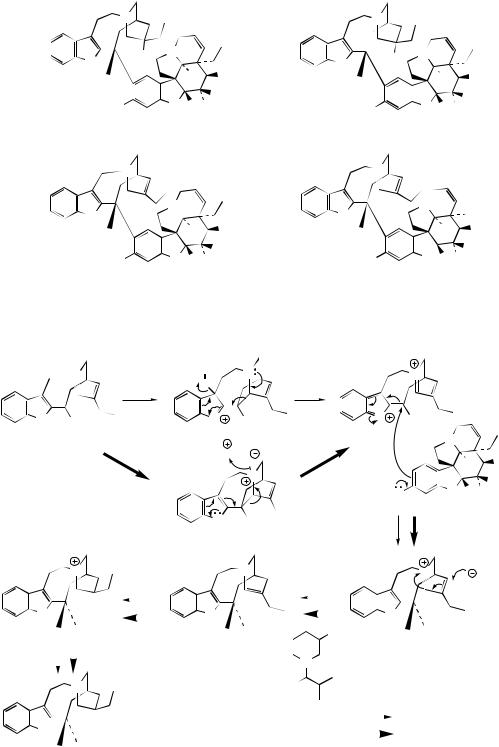
ALKALOIDS DERIVED FROM TRYPTOPHAN |
355 |
N |
|
|
|
|
N |
HO |
N |
|
|
|
|
|
||
|
|
|
|
|
H |
|
|
H |
OAc |
MeO2C |
|
N |
|
OH |
|
|
|||
MeO |
|
H CO2Me |
||
R = Me, |
|
R |
|
|
vinblastine |
|
|
||
R = CHO, vincristine |
|
|
||
N |
|
|
|
|
N |
|
N |
|
|
|
|
|
|
|
H |
|
|
H |
OAc |
MeO2C |
|
N |
|
OH |
|
|
|||
MeO |
|
H CO2Me |
||
|
|
Me |
|
|
vinorelbine
N |
|
|
|
||||
HO |
N |
|
|
||||
|
|
|
|||||
N |
|
|
|
||||
H |
|
H |
OH |
||||
MeO2C |
|
|
|
|
N |
|
OH |
|
|
||||||
MeO |
H CONH2 |
||||||
vindesine |
Me |
|
|
||||
|
|
|
|||||
N |
|
|
|
||||
N |
N |
|
|
||||
|
|
|
|||||
H |
|
H |
OAc |
||||
MeO2C |
|
|
N |
|
OH |
||
|
|
||||||
MeO |
H CO2Me |
||||||
|
|
|
|
|
Me |
|
|
anhydrovinblastine
Figure 6.80
 N
N
peroxidase
N CO2Me H
catharanthine
m-chloroperbenzoic acid
loss of leaving group precipitates ring opening: resembles a reverse Mannich-like reaction
OH |
N |
|
N |
nucleophilic attack on |
|
O |
|
||||
|
|
|
to conjugated iminium |
||
|
|
|
|
system |
|
N |
CO2Me |
N |
CO2Me |
|
|
H |
|
H |
|
|
|
|
|
(CF3CO)2O |
|
N |
|
CF3CO |
|
|
|
|
|
O |
|
|
H |
OAc |
|
|
|
|
|||
|
N |
|
|
|
OH |
|
|
|
|
|
|
|
|
MeO |
|
N H CO2Me |
|
|
|
|
|
Me |
|
N |
|
|
|
vindoline (V) |
|
CO2Me |
|
|
|
|
|
H |
|
|
|
|
|
catharanthine N-oxide |
|
|
|
|
|
|
|
|
N |
|
|
|
|
|
N |
|
|
|
|
|
|
|
|
|
N |
||
|
|
|
|
|
|
|
O |
|
|
|
NADH |
H |
|||||||||
|
|
|
|
|
|
|
|
|
|
|
|||||||||||
|
|
|
|
|
|
|
|
|
|
|
|
|
|
|
|
|
|
|
|
|
|
|
N |
|
|
OH |
|
N |
|
|
|
|
|
|
|
|
|
N |
|||||
|
|
|
|
|
|
|
|
|
|
|
|
|
|||||||||
|
|
|
|
|
|
|
|
|
|
|
|
|
|
|
|
|
|||||
|
H |
|
|
|
|
|
|
|
H |
|
|
|
|
|
|
|
|
|
H |
||
|
MeO2C V |
|
FeCl3 |
|
MeO2C V |
|
|
|
CONH2 MeO2C V |
||||||||||||
|
|
|
|
|
|
O2 |
|
|
|
|
|
|
|
|
|
|
|
|
|
||
NADH |
|
|
|
NaBH4 |
|
|
|
|
|
|
|
|
|
|
|
|
|
||||
|
|
|
|
|
N |
||||||||||||||||
|
|
|
|
|
|
|
|
|
|
|
|
||||||||||
|
|
|
N |
|
|
|
|
|
|
NaO2C |
|||||||||||
|
N |
|
|
OH |
|
|
|
|
|
|
|
|
|
|
|
biosynthetic pathway |
|||||
|
|
|
|
|
|
|
|
|
|
|
|
|
|
||||||||
|
|
|
|
|
|
|
|
|
|
|
|
|
|
||||||||
|
|
|
|
|
|
|
|
|
|
|
|
|
|
synthetic route |
|||||||
|
|
|
|
|
|
|
|
|
|
|
|
|
|
|
|
|
|
||||
|
H |
V |
|
|
|
|
|
|
|
|
|
|
|
|
|
|
|
||||
|
|
|
|
|
|
|
|
|
|
|
|
|
|
|
|
|
|
||||
|
MeO2C |
|
|
|
|
|
|
|
|
|
|
|
|
|
|
|
|
|
|||
|
|
|
|
|
|
|
|
|
|
|
|
|
|
|
|
|
|
|
|
||
|
vinblastine |
|
|
|
|
|
|
|
|
|
|
|
|
|
|
|
|
|
|||
Figure 6.81

356 ALKALOIDS
Catharanthus
The Madagascar periwinkle Catharanthus roseus (= Vinca rosea) (Apocynaceae) is a small herb or shrub originating in Madagascar, but now common in the tropics and widely cultivated as an ornamental for its shiny dark green leaves and pleasant five-lobed flowers. Drug material is now cultivated in many parts of the world, including the USA, Europe, India, Australia, and South America.
Because of its folklore usage as a tea for diabetics, the plant was originally investigated for potential hypoglycaemic activity. Although plant extracts had no effects on blood sugar levels in rabbits, the test animals succumbed to bacterial infection due to depleted white blood cell levels (leukopenia). The selective action suggested anticancer potential for the plant, and an exhaustive study of the constituents was initiated. The activity was found in the alkaloid fraction, and more than 150 alkaloids have been characterized in the plant. These are principally terpenoid indole alkaloids, many of which are known in other plants, especially from the same family. Useful antitumour activity was demonstrated in a number of dimeric indole alkaloid structures (more correctly bis-indole alkaloids), including vincaleukoblastine, leurosine, leurosidine, and leurocristine. These compounds became known as vinblastine, vinleurosine, vinrosidine, and vincristine respectively, the vinprefix being a consequence of the earlier botanical nomenclature Vinca rosea, which was commonly used at that time. The alkaloids vinblastine and vincristine (Figure 6.80) were introduced into cancer chemotherapy and have proved to be extremely valuable drugs.
Despite the minor difference in structure between vinblastine and vincristine, a significant difference exists in the spectrum of human cancers that respond to the drugs. Vinblastine (Figure 6.80) is used mainly in the treatment of Hodgkin’s disease, a cancer affecting the lymph glands, spleen, and liver. Vincristine (Figure 6.80) has superior antitumour activity compared to vinblastine but is more neurotoxic. It is clinically more important than vinblastine, and is especially useful in the treatment of childhood leukaemia, giving a high rate of remission. Some other cancer conditions, including lymphomas, small cell lung cancer, and cervical and breast cancers, also respond favourably. The alkaloids need to be injected, and both generally form part of a combination regimen with other anticancer drugs. Vindesine (Figure 6.80) is a semi-synthetic derivative of vinblastine, which has been introduced for the treatment of acute lymphoid leukaemia in children. Vinorelbine (Figure 6.80), an anhydro derivative of 8 -norvinblastine, is a newer semi-synthetic modification obtained from anhydrovinblastine (Figure 6.80), where the indole.C2N bridge in the catharanthine-derived unit has been shortened by one carbon. It is orally active and has a broader anticancer activity yet with lower neurotoxic side-effects than either vinblastine or vincristine. These compounds all inhibit cell mitosis, acting by binding to the protein tubulin in the mitotic spindle, preventing polymerization into microtubules, a mode of action shared with other natural agents, e.g. colchicine (see page 343) and podophyllotoxin (see page 136).
A major problem associated with the clinical use of vinblastine and vincristine is that only very small amounts of these desirable alkaloids are present in the plant. Although the total alkaloid content of the leaf can reach 1% or more, over 500 kg of catharanthus is needed to yield 1 g of vincristine. This yield (0.0002%) is the lowest of any medicinally important alkaloid isolated on a commercial basis. Extraction is both costly and tedious, requiring large quantities
(Continues)

ALKALOIDS DERIVED FROM TRYPTOPHAN |
357 |
(Continued )
of raw material and extensive use of chromatographic fractionations. The growing importance of vincristine relative to vinblastine as drugs is not reflected in the plant, which produces a much higher proportion of vinblastine. Fortunately, it is possible to convert vinblastine into vincristine by controlled chromic acid oxidation or via a microbiological N-demethylation using Streptomyces albogriseolus. Considerable effort has been expended on the semisynthesis of the ‘dimeric’ alkaloids from ‘monomers’ such as catharanthine and vindoline, which are produced in C. roseus in much larger amounts. Efficient, stereospecific coupling has eventually been achieved, and it is now possible to convert catharanthine and vindoline into vinblastine in about 40% yield. The process used is a biomimetic one, virtually identical to the suggested biosynthetic process, and is also included in Figure 6.81. Catharanthine- N-oxide is employed instead of the peroxidase-generated peroxide, and this couples readily in trifluoroacetic anhydride with vindoline in almost quantitative yield. Subsequent reduction, oxidation, and reduction steps then give vinblastine via the same ‘biosynthetic’ intermediates. It is particularly interesting that the most effective reducing agents for the transformation of the dihydropyridinium compound into the tetrahydropyridine were N-substituted 1,4- dihydronicotinamides, simpler analogues of NADH, the natural reducing agent. Excellent yields of anhydrovinblastine (the starting material for vinorelbine production) (Figure 6.80) can also be obtained by electrochemical oxidation of catharanthine/vindoline. These syntheses should improve the supply of these alkaloids and derivatives, and also allow more detailed studies of structure–activity relationships to be undertaken. This group of compounds is still of very high interest, and development programmes for analogues continue.
Ajmalicine (see rauwolfia, page 353) is present in the roots of Catharanthus roseus at a level of about 0.4%, and this plant is used as a commercial source in addition to Rauwolfia serpentina.
Iboga
The Iboga group of terpenoid indole alkaloids takes its name from Tabernanthe iboga (Apocynaceae), a shrub from the Congo and other parts of equatorial Africa. Extracts from the root bark of this plant have long been used by indigenous people in rituals, to combat fatigue, and as an aphrodisiac. The root bark contains up to 6% indole alkaloids, the principal component of which is ibogaine (Figure 6.82). Ibogaine is a CNS stimulant, and is also psychoactive. In large doses, it can cause paralysis and respiratory arrest. Ibogaine is of interest as a potential drug for relieving heroin craving in drug addicts. Those who use the drug experience hallucinations from the ibogaine, but it is claimed they emerge from this state with a significantly reduced opiate craving. A number of deaths resulting from the unsupervised use of ibogaine has led to its being banned in some countries.
contains a C9 Corynanthe type unit and its relationship to dehydrogeissoschizine is indicated in Figure 6.82. Vincamine still retains a C10 Aspidosperma unit, and it originates from tabersonine by a series of reactions that involve cleavage of bonds to both α and β positions of the indole (Figure 6.82).
Alkaloids like preakuammicine (Figure 6.79) and akuammicine (Figure 6.75) contain the C10 and C9 Corynanthe type terpenoid units respectively. They are, however, representatives of a subgroup of Corynanthe alkaloids termed the Strychnos type because of their structural similarity to many of the alkaloids found in Strychnos
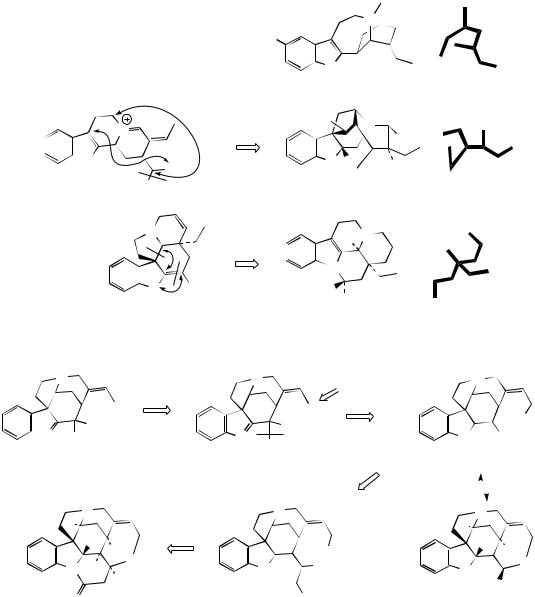
358 |
|
|
|
|
ALKALOIDS |
|
|
|
|
|
|
||
|
|
|
|
|
|
|
|
N |
|
|
|
|
|
|
|
|
|
|
MeO |
|
|
|
|
|
|
|
|
|
|
|
|
|
|
|
N |
|
|
|
|
|
|
|
|
|
|
|
|
|
|
|
|
|
|
|
|
|
|
|
|
|
|
|
|
|
|
|
|
|
|
|
|
|
|
|
|
|
H |
|
C9 Iboga |
|
|||
|
|
|
|
|
|
|
ibogaine |
|
|
|
|
|
|
|
N |
|
|
|
|
|
HO |
N |
|
|
|
|
|
|
|
|
|
|
|
|
|
|
|
|
|
||
|
|
|
|
|
|
|
|
OH |
|
|
|
|
|
|
N |
|
|
|
|
|
N |
H |
|
|
|
|
|
|
|
|
|
|
|
|
|
|
|
||||
|
|
CHO |
|
|
|
H |
|
|
|
|
|||
|
|
|
|
|
|
|
|
|
|||||
|
H |
|
|
|
|
Me |
|
|
|
|
|||
|
|
|
|
|
|
|
|
|
|
||||
dehydrogeissoschizine |
|
CO2Me |
|
|
|
ajmaline |
C9 Corynanthe |
|
|||||
(keto form) |
|
|
|
|
|
|
|
|
|
|
|
|
|
|
|
|
N |
|
|
|
|
H N |
|
|
|
|
|
|
|
|
|
|
|
|
|
|
|
|
|
|
|
|
|
|
N |
CO2Me |
|
|
N |
|
|
|
|
|
|
|
|
|
|
|
|
|
|
|
|
|
|||
|
|
|
|
|
|
|
|
|
|
||||
|
|
|
|
|
HO |
CO2Me |
|
|
|
|
|
||
|
|
|
|
|
|
|
|
|
|
||||
|
|
|
H |
|
|
|
|
|
|
|
|
|
|
|
|
tabersonine |
|
|
|
vincamine |
Aspidosperma |
|
|||||
|
|
|
|
|
Figure 6.82 |
|
|
|
|
|
|
|
|
N |
|
|
|
N |
|
|
O |
|
N |
|
|||
|
|
|
|
|
|
|
|
|
|
|
|
|
|
|
CH2OH |
|
|
|
CHO |
|
|
|
|
|
|
HO |
|
|
|
|
|
|
|
|
|
|
|
CHO |
|
||
N CO2Me |
|
|
|
N |
|
|
|
N |
|
|
|
||
|
|
|
|
|
CO2Me |
|
|
|
H |
|
|
|
|
preakuammicine |
|
|
|
|
acetyl-CoA |
Wieland–Gumlich aldehyde |
|||||||
|
|
|
|
|
|
|
|
|
|
|
|||
|
N |
|
|
|
N |
|
|
aldol reaction with |
|
|
|
|
|
|
|
|
|
|
|
|
|
|
|
||||
|
|
|
|
|
|
N |
|
||||||
|
|
|
|
|
|
acetyl-CoA |
|
|
|||||
H |
|
|
|
|
|
|
|
H |
|
|
|
|
|
|
H |
|
|
|
|
|
HO |
|
|
|
H |
|
|
|
H |
O |
|
|
|
|
|
|
|
H |
O |
||
N H |
|
N |
|
OH |
|
N |
|
H |
|||||
|
|
|
|
|
|
||||||||
|
|
|
|
|
|
|
|
||||||
|
H |
|
|
|
H |
|
|
|
H |
|
HO |
|
|
|
|
|
|
|
|
|
|
|
|
|
|
||
|
O |
|
|
|
CO2H |
|
Wieland–Gumlich aldehyde |
||||||
|
strychnine |
|
|
|
|
|
|
|
(hemiacetal form) |
|
|||
Figure 6.83
species (Loganiaceae), e.g. S. nux-vomica , noteworthy examples being the extremely poisonous strychnine (Figure 6.83) and its dimethoxy analogue brucine (Figure 6.84). The non-tryptamine portion of these compounds contains 11 carbons, and is constructed from an iridoid-derived C9 unit, plus two further carbons supplied from acetate. The pathway to strychnine in Figure 6.83 involves loss
of one carbon from a preakuammicine-like structure via hydrolysis/decarboxylation and then addition of the extra two carbons by aldol condensation with the formyl group, complexed as a hemiacetal in the so-called Wieland–Gumlich aldehyde. The subsequent formation of strychnine from this hemiacetal is merely construction of ether and amide linkages.
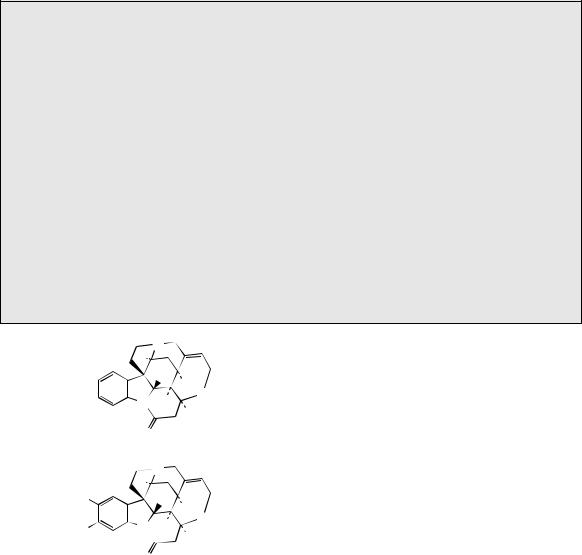
ALKALOIDS DERIVED FROM TRYPTOPHAN |
359 |
Nux-vomica
Nux-vomica consists of the dried ripe seeds of Strychnos nux-vomica (Loganiaceae), a small tree found in a wide area of East Asia extending from India to Northern Australia. The fruit is a large berry with a hard coat and a pulpy interior containing three to five flattish grey seeds. These seeds contain 1.5–5% of alkaloids, chiefly strychnine (about 1.2%) and brucine (about 1.6%) (Figure 6.82). Strychnine is very toxic, affecting the CNS and causing convulsions. This is a result of binding to receptor sites in the spinal cord that normally accommodate glycine. Fatal poisoning (consumption of about 100 mg by an adult) would lead to asphyxia following contraction of the diaphragm. It has found use as a vermin killer, especially for moles. Its only medicinal use is in very small doses as an appetite stimulant and general tonic, sometimes with iron salts if the patient is anaemic. Brucine is considerably less toxic. Both compounds have been regularly used in synthetic chemistry as optically active bases to achieve optical resolution of racemic acids. Seeds of the related Strychnos ignatii have also served as a commercial source of strychnine and brucine.
Of biochemical interest is the presence of quite significant amounts (up to 5%) of the iridoid glycoside loganin (see page 188) in the fruit pulp of Strychnos nux-vomica. This compound is, of course, an intermediate in the biosynthesis of strychnine and other terpenoid indole alkaloids.
|
|
N |
|
H |
|
|
|
H |
|
|
H |
|
N |
O |
|
H |
|
|
|
H |
|
O |
|
|
strychnine |
|
|
|
N |
|
H |
|
MeO |
|
H |
|
|
H |
|
|
|
|
N |
O |
|
||
MeO |
H |
|
|
H |
|
|
|
|
O brucine
Figure 6.84
The arrow poison curare, when produced from Chondrodendron species (Menispermaceae), contains principally the bis-benzyltetrahydroisoquino- line alkaloid tubocurarine (see page 324). Species of Strychnos, especially S. toxifera, are employed in making loganiaceous curare, and biologically active alkaloids isolated from such preparations have been identified as a series of toxiferines, e.g. C-toxiferine (Figure 6.85). The structures appear remarkably complex, but may be envisaged as a combination of two Wieland–Gumlich
aldehyde-like molecules (Figure 6.85). The pres-
ence |
of two quaternary nitrogens, separated |
by an |
appropriate distance, is responsible for |
the curare-like activity (compare tubocurarine and synthetic analogues, page 326). Alcuronium (Figure 6.85) is a semi-synthetic skeletal muscle relaxant produced from C-toxiferine (see curare, page 327).
Ellipticine (Figure 6.86) contains a pyridocarbazole skeleton, which is also likely to be formed from a tryptamine–terpenoid precursor. Although little evidence is available, it is suggested that a precursor like stemmadenine may undergo transformations that effectively remove the two-carbon bridge originally linking the indole and the nitrogen in tryptamine (Figure 6.86). The remaining C9 terpenoid fragment now contain-
ing |
the tryptamine nitrogen can then be used |
to |
generate the rest of the skeleton. Ellipticine |
is |
found in Ochrosia elliptica (Apocynaceae) |
and related species and has useful anticancer properties.
Quinoline Alkaloids
Some of the most remarkable examples of terpenoid indole alkaloid modifications are to be found in the genus Cinchona (Rubiaceae), in the alkaloids quinine, quinidine, cinchonidine,
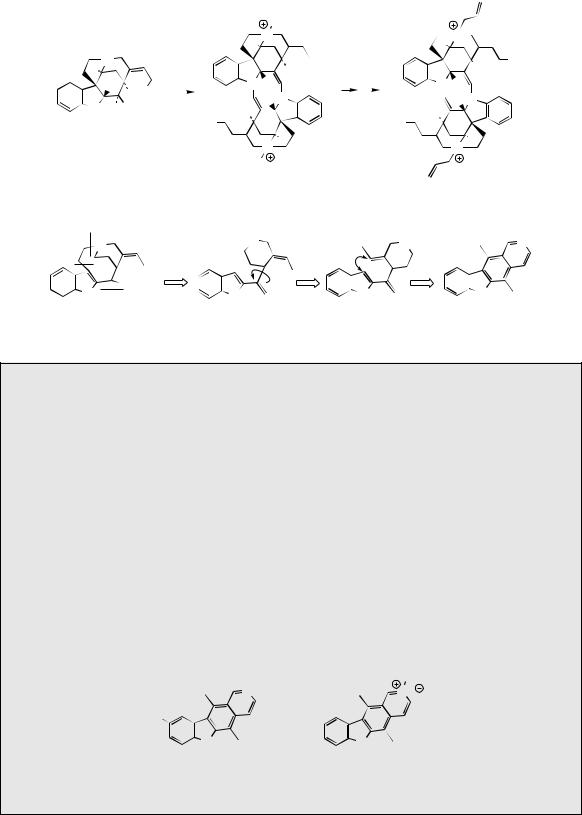
360 |
|
|
|
|
|
ALKALOIDS |
|
|
|
|
|
|
|
|
|
|||
|
|
|
|
|
|
Me |
|
|
|
|
|
|
|
|
|
|||
|
|
via intermolecular |
|
H N |
|
|
|
|
|
H |
N |
|||||||
|
|
Schiff base reactions |
|
|
|
|
|
|
||||||||||
|
N |
|
|
|
|
|
|
|
OH |
|
|
|
|
|
|
|
|
OH |
|
H |
|
x 2 |
|
H |
chemically |
|
|
H |
|||||||||
|
|
|
|
|
||||||||||||||
|
H |
|
|
N H |
|
|
|
|
||||||||||
|
|
|
|
|
|
|
|
N H |
||||||||||
|
H OH |
|
|
|
|
|
|
|
|
|||||||||
|
|
|
|
|
H N |
|
|
|
|
|
|
H N |
||||||
|
|
|
|
|
|
|
|
|
|
|||||||||
|
N H CHO |
|
|
|
|
|
|
|
|
|
|
|
||||||
|
H |
|
|
|
|
|
H |
|
|
|
||||||||
|
H |
|
|
HO |
|
|
|
|
|
|
|
HO |
|
|
|
|||
Wieland–Gumlich aldehyde |
|
H |
|
|
|
|
|
|
H |
|||||||||
|
|
|
|
|
|
|
||||||||||||
|
|
|
|
|
|
|
|
|
|
|
|
|||||||
|
|
|
|
|
|
N |
|
|
|
|
|
|
N |
|||||
|
|
|
|
|
|
Me |
|
|
|
|
|
|
|
|
|
|||
|
|
|
|
|
C-toxiferine |
|
|
|
|
|
|
alcuronium |
||||||
|
|
|
|
|
|
Figure 6.85 |
|
|
|
|
|
|
|
|
|
|||
|
|
|
|
|
|
H |
|
|
|
|
|
|
|
|
|
|||
|
N |
|
|
|
|
N |
|
|
NH |
|
|
N |
||||||
|
N |
CH2OH |
|
N |
|
N |
|
N |
|
|
|
|
|||||
|
CO2Me |
|
|
|
||||
|
H |
|
H |
|
H |
|
H |
|
|
stemmadenine |
|
|
|
|
ellipticine |
||
Figure 6.86
Ellipticine
Ellipticine (Figure 6.86) and related alkaloids, e.g. 9-methoxyellipticine (Figure 6.87), are found in the bark of Ochrosia elliptica (Apocynaceae) and other Ochrosia species. Clinical trials with these alkaloids and a number of synthetic analogues showed them to be potent inhibitors of several cancerous disorders, but pre-clinical toxicology indicated a number of side-effects, including haemolysis and cardiovascular effects. Ellipticines are planar molecules that intercalate between the base pairs of DNA and cause a partial unwinding of the helical array. There is a some correlation between the degree of unwinding and the biological properties, those showing the largest unwinding inhibiting the greatest number of cancerous cells. Recent research suggests there may be more than one mechanism of action, however. Ellipticine is oxidized in vivo mainly to 9-hydroxyellipticine, which has an increased activity, and it is believed that this may in fact be the active agent. Poor water-solubility of ellipticine and derivatives gave problems in formulation for clinical use, but quaternization of 9-hydroxyellipticine to give the water-soluble 9-hydroxy-2-N-methylellipticinium acetate (elliptinium acetate) (Figure 6.87) has produced a highly active material, of value in some forms of breast cancer, and perhaps also in renal cell cancer. A variety of such quaternized derivatives is being tested, and some water-soluble N-glycosides also show high activity.
|
|
Me |
|
|
N |
N |
OAc |
|
|
|
|
MeO |
HO |
|
|
|
N |
N |
|
|
|
||
|
H |
H |
|
9-methoxyellipticine |
elliptinium acetate |
|
|
Figure 6.87
